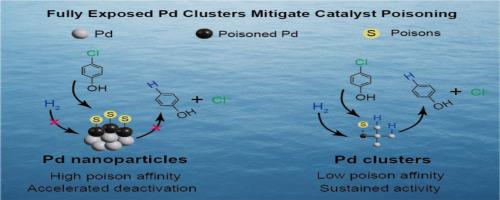完全暴露的钯簇减轻了水污染物还原过程中的催化剂中毒
IF 12.4
1区 环境科学与生态学
Q1 ENGINEERING, ENVIRONMENTAL
引用次数: 0
摘要
钯基催化剂在水处理应用中具有很大的前景,但往往受到硫和天然有机物(NOM)的毒害。在这里,我们提出了一种光化学策略,通过氧配位合成完全暴露的Pd簇,以减轻硫和NOM中毒。这些超小Pd团簇在富硫(50µM)和富氮(10 mg C/L)水基质中有效催化碳-卤素键的加氢。实验和计算研究表明,在完全暴露的Pd簇中,氧配位的Pd-Pd位点在顶部和桥位上对硫和NOM的吸附较弱,从而减轻了催化剂中毒。相比之下,传统的钯纳米粒子主要具有金属钯位点,在空心位点上强烈结合中毒物质,导致快速失活。这些完全暴露的簇不仅可以减轻硫和有机物质的失活,还可以在广泛的水污染物和复杂的水基质中保持高的催化活性。这项工作提出了一种新的设计策略,用于开发强大的和选择性的加氢催化剂用于高级水处理应用。本文章由计算机程序翻译,如有差异,请以英文原文为准。


Fully exposed palladium clusters mitigate catalyst poisoning during water contaminant reduction
Palladium-based catalysts hold great promise for water treatment applications but are often poisoned by sulfur species and natural organic matter (NOM). Here, we present a photochemical strategy to synthesize fully exposed Pd clusters through oxygen coordination to mitigate sulfur and NOM poisoning. These ultrasmall Pd clusters efficiently catalyze the hydrogenation of carbon–halogen bonds in sulfur-rich (50 µM) and NOM-rich (10 mg C/L) water matrices. Experimental and computational studies reveal that oxygen-coordinated Pd-Pd sites in fully exposed Pd clusters exhibit weaker sulfur and NOM adsorption at top and bridge sites, thereby mitigating catalyst poisoning. In contrast, conventional Pd nanoparticles possess predominantly metallic Pd sites that strongly bind poisoning species at hollow sites, resulting in rapid deactivation. These fully exposed clusters not only mitigate deactivation by sulfur and organic species, but also maintain high catalytic activity across a broad range of water contaminants and complex water matrices. This work presents a new design strategy for developing robust and selective hydrogenation catalysts for advanced water treatment applications.
求助全文
通过发布文献求助,成功后即可免费获取论文全文。
去求助
来源期刊

Water Research
环境科学-工程:环境
CiteScore
20.80
自引率
9.40%
发文量
1307
审稿时长
38 days
期刊介绍:
Water Research, along with its open access companion journal Water Research X, serves as a platform for publishing original research papers covering various aspects of the science and technology related to the anthropogenic water cycle, water quality, and its management worldwide. The audience targeted by the journal comprises biologists, chemical engineers, chemists, civil engineers, environmental engineers, limnologists, and microbiologists. The scope of the journal include:
•Treatment processes for water and wastewaters (municipal, agricultural, industrial, and on-site treatment), including resource recovery and residuals management;
•Urban hydrology including sewer systems, stormwater management, and green infrastructure;
•Drinking water treatment and distribution;
•Potable and non-potable water reuse;
•Sanitation, public health, and risk assessment;
•Anaerobic digestion, solid and hazardous waste management, including source characterization and the effects and control of leachates and gaseous emissions;
•Contaminants (chemical, microbial, anthropogenic particles such as nanoparticles or microplastics) and related water quality sensing, monitoring, fate, and assessment;
•Anthropogenic impacts on inland, tidal, coastal and urban waters, focusing on surface and ground waters, and point and non-point sources of pollution;
•Environmental restoration, linked to surface water, groundwater and groundwater remediation;
•Analysis of the interfaces between sediments and water, and between water and atmosphere, focusing specifically on anthropogenic impacts;
•Mathematical modelling, systems analysis, machine learning, and beneficial use of big data related to the anthropogenic water cycle;
•Socio-economic, policy, and regulations studies.
 求助内容:
求助内容: 应助结果提醒方式:
应助结果提醒方式:


